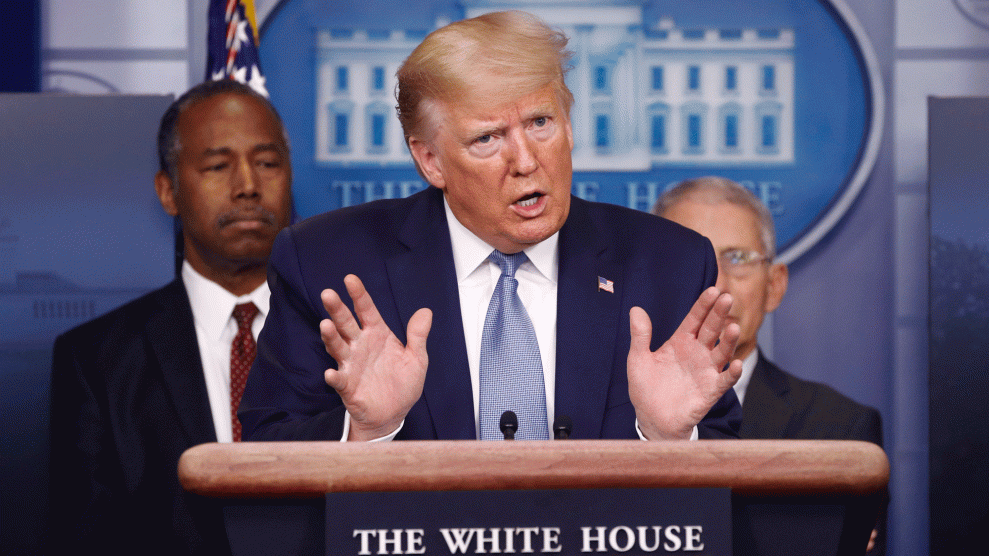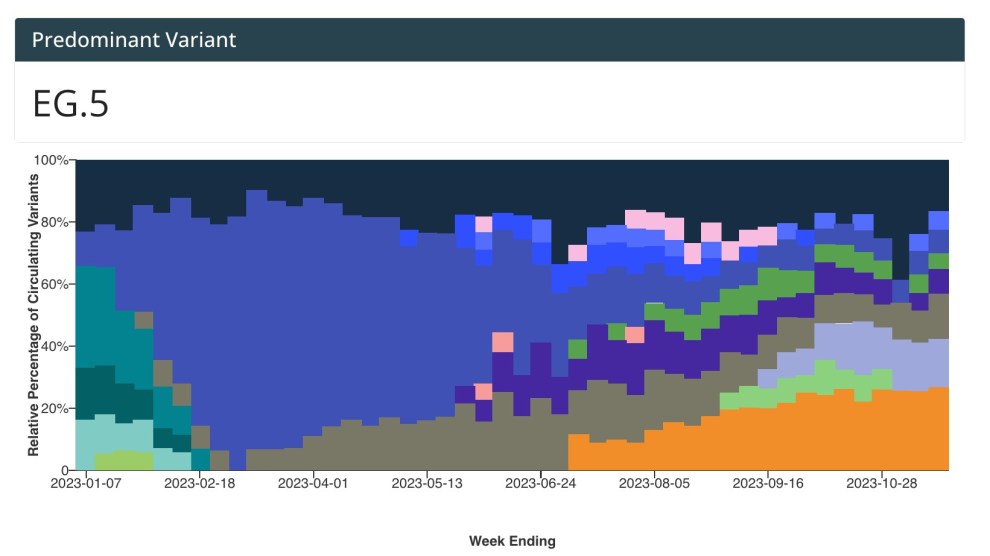
Patrick Semansky/AP
That didn’t take long. Donald Trump already seems to be growing tired and frustrated with doing the right thing.
After about two months of deadly delays and denials, Trump a week ago finally began pushing a public health initiative to counter the coronavirus pandemic, promoting the White House’s “15 Days to Slow the Spread” campaign, which called for social distancing, teleworking, and limiting social gatherings to 10 or fewer people. This was not as aggressive a stance as some public health experts urged, but it was far better than the message Trump conveyed on March 4, when he told Sean Hannity, “You know, we have thousands or hundreds of thousands of people that get better, just by, you know, sitting around and even going to work.”
Yet now it appears that Trump is considering pivoting from the expert-driven plan of containing the virus by minimizing social interactions. On Sunday night, he tweeted, “WE CANNOT LET THE CURE BE WORSE THAN THE PROBLEM ITSELF. AT THE END OF THE 15 DAY PERIOD, WE WILL MAKE A DECISION AS TO WHICH WAY WE WANT TO GO!” This seemed to suggest Trump worried that the strict measures taken to counter the pandemic and save lives might be causing too much economic pain.
Soon after, Trump retweeted a number of conservative activists who explicitly made this troubling point. One declared, “Correct. 15 days, then we keep the high-risk groups protected as necessary and the rest of us go back to work.” Another railed that the current measures were leading to the “Destruction of the economy.” A third said, “Flatten the curve NOT the economy.” And Trump also retweeted an unverified account apparently belonging to a Southern California sex counselor who proclaimed, “The fear of the virus cannot collapse our economy that President Trump has built up. We The People are smart enough to keep away from others if we know that we are sick or they are sick! After 15 days are over the world can begin to heal!” Here was Trump promoting the position that come next week those damn annoying and inconvenient social distancing practices should be dropped and the nation should just depend on citizens being able to sort out, on their own, how to avoid sharing the virus.
Meanwhile, the New York Times reported that “at the White House, in recent days, there has been a growing sentiment that medical experts were allowed to set policy that has hurt the economy, and there has been a push to find ways to let people start returning to work.” The story noted, “Trump has become frustrated with Dr. [Anthony] Fauci’s blunt approach at the briefing lectern, which often contradicts things the president has just said, according to two people familiar with the dynamic.” Fauci has been saying that severe social distancing measures will likely be required for weeks to come—longer than those 15 days Trump initially called for. That’s not going over well with the boss. And on Monday, the Wall Street Journal reported, “The White House is discussing easing social-distancing guidelines as early as next week as advisers and business leaders push President Trump to boost an economy beset by deepening job losses nationwide.”
Put all this together and a clear and harsh impression emerges: Trump is willing to weaken public health measures in order to try to prevent further economic damage. To put it crassly, he seems to care more about economic metrics than preventing the death of Americans.
Why would that be? It was no secret that until the coronavirus crisis hit, Trump’s primary argument for reelection was based on the economy, which at that point, according to conventional measurements (the stock market, the unemployment rate), was performing well. The pandemic has blasted away this reason for reelection. The current forecasts—up to 30 percent unemployment, GDP contraction by 20 percent—are a nightmare for the nation and for a president facing voters in several months. (And the ongoing economic calamity has had a devastating impact on Trump’s own businesses.)
Trump, in a way, feared this possibility from the start. As the killer virus was gaining a foothold in the United States, he reportedly opposed aggressive testing because that would show higher numbers of infections, and larger numbers were bad for his political prospects. That is, he placed his own personal interests ahead of those of the nation.
Trump is a numbers guy—when they work for him. And in the early weeks of the epidemic, he tried to deploy statistics to downplay the threat. On March 9, long after experts in and out of government were citing the immediate need for widespread and comprehensive action, Trump zapped out a tweet suggesting the coronavirus was no big deal because the flu caused the death of 37,000 Americans in 2019 and the new virus had so far only claimed 22. (“Think about that!” he declared.)
So last year 37,000 Americans died from the common Flu. It averages between 27,000 and 70,000 per year. Nothing is shut down, life & the economy go on. At this moment there are 546 confirmed cases of CoronaVirus, with 22 deaths. Think about that!
— Donald J. Trump (@realDonaldTrump) March 9, 2020
See? Numbers said it wasn’t so bad.
But now Trump has two sets of numbers to confront. The horrifying daily stats on the spread of COVID-19, including the rising death tally, and the terrifying measurements of the free-falling economy. A narcissist, Trump is more fearful of the second category, which affects his future in a manner he can fully comprehend.
With this latest spout of tweets, Trump is signaling that he’s eager to shout “enough already” regarding the restrictive measures designed to impede the transmission of the virus. He is drawn to the idea of soon easing up and encouraging folks without symptoms to head back into the world. If this occurs, infected people without symptoms will fill streets, offices, shops, mass transportation, schools, churches, restaurants, and other public places. But because there is still no nationwide comprehensive testing system, most of these infected persons will have no idea they are transmitting the virus.
Trump’s endorsement of the magical thinking that Americans can return to work without infecting others is unsettling and alarming. This would place millions of Americans in danger, particularly the most vulnerable: the elderly, the already-sick, and those with limited access to health care. It would mean more death. And such a move would further increase the pressure on the nation’s buckling health care system. That, too, would mean more death.
Trump’s tweets and retweets are a sign he believes the cost to the economy of an effective containment policy is too high. Perhaps partly (or wholly) because that cost also threatens his reelection. Yet health care experts are adamantly saying the current policies need to remain in place for some time—and probably should be tighter. So Trump faces a serious tradeoff. Does he want to follow scientific expertise and do all that is necessary to safeguard Americans? Or does he want to relax restraints in an effort to limit the harm to the economy (even if doing so might allow the pandemic to burn wider and hotter and further threaten the economy)?
It’s true that most Americans do not face a lethal risk from the coronavirus. But many do. (This group is mostly older Americans, but younger citizens are not entirely safe from COVID-19.) How much does Trump care about these people? Is he willing to sacrifice thousands of them—or a lot more—in a (probably) misguided bid to restart the economy because that’s what he deems is best for his reelection campaign? This is a helluva calculation for a politician to make. But Trump’s latest noises are those of a man who believes more deaths are not as bad as more economic hardship—and someone who gives the appearance he is willing to pave the way to electoral victory with the bodies of fallen Americans.















